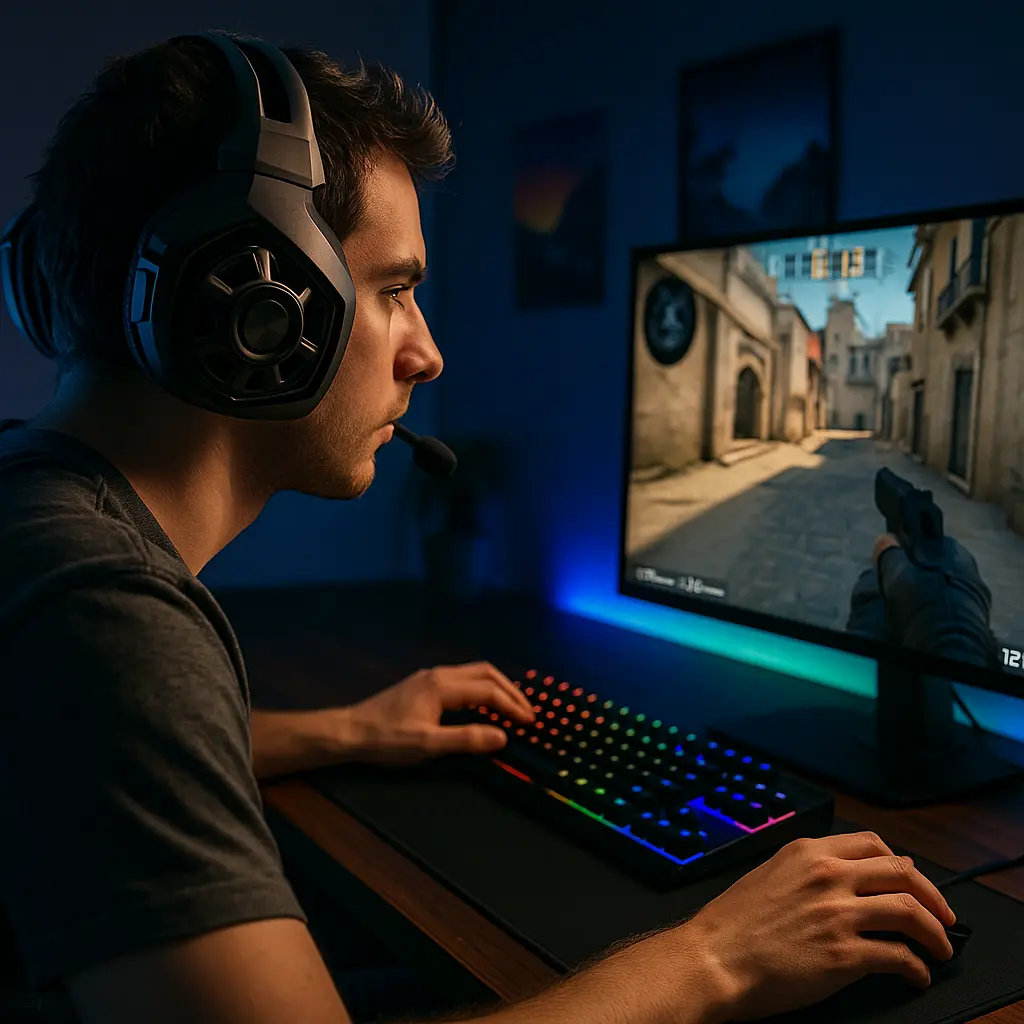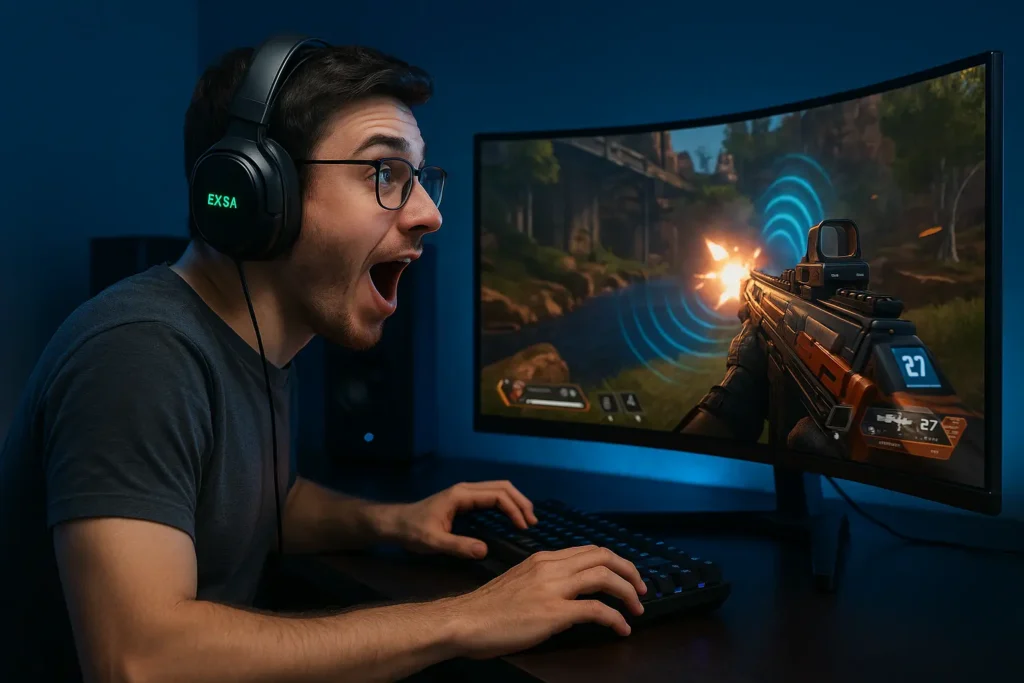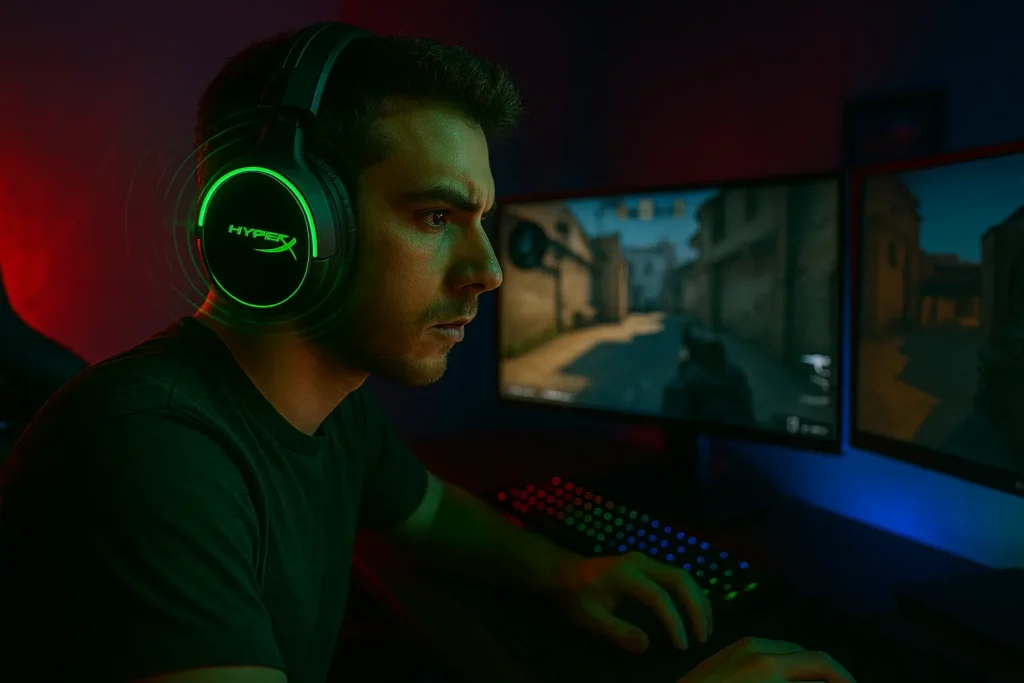Surround sound, at its core, is about simulating audio as if it’s coming from multiple directions. If you’ve ever sat in a movie theatre and noticed how a helicopter feels like it’s flying behind you, or how gunshots pop from the left and right in a battle scene, that’s the effect surround sound tries to replicate. In headphones, it’s trickier. You’ve only got two drivers, one for each ear, so the headset has to rely on some clever tricks — or, in the case of some high-end models, cram in multiple drivers per earcup.
I’ve tested quite a few headsets that promise “cinematic surround sound,” and the results vary wildly. With the EKSA E900 Pro, for example, the company advertises 7.1 surround, but it’s actually a virtual effect. That said, when I loaded up Hellblade: Senua’s Sacrifice — a game built around spatial audio — it genuinely felt like voices were circling around my head. It was eerie in the best way.
CORSAIR’s HS80, on the other hand, uses Dolby Atmos, and when I tested it during a Halo Infinite session, the gunfire ricocheted in a way that stereo simply couldn’t do. Whether it’s better or not depends on what you’re playing, but it absolutely adds presence.
The basic idea is this: surround sound in headphones can either come from actual hardware (multiple drivers in each earcup), or from software that simulates directional sound using processing. Both approaches aim to wrap sound around your head, but how they do it — and how effective it is — can vary a lot.
True Surround vs Virtual Surround
Let’s clear this up early — true surround and virtual surround are not the same thing.
True surround headphones have multiple drivers in each earcup. I’ve tested the old ASUS Strix 7.1 headset a while ago, which literally had five drivers per side. When positioned correctly, you could absolutely tell where a sound was coming from in CS:GO. I could hear a reload clip sound to my back-left and react before my opponent peeked. It was bulky, though — no getting around that. Those earcups looked like alien tech and felt like you strapped a subwoofer to each ear.

Virtual surround is what most headsets use now. Rather than cramming in extra hardware, they simulate positional audio through software. It sounds worse on paper, but in actual use, it often sounds cleaner and more balanced. CORSAIR’s Virtuoso XT, for instance, uses virtual surround via Dolby Headphone and it’s incredibly convincing. I tried it in The Witcher 3, and when I was riding Roach through the swamps near Crookback Bog, the layered sound of crows, insects, and Geralt’s voice felt genuinely immersive.
Steam has some support built-in for spatial audio in VR games, and I’ve seen a few threads praising virtual setups over true 5.1 headsets. It’s not that one is strictly better — it’s that virtual surround is more versatile and far less clunky.
How Virtual Surround Works
This is where it gets technical — but it’s also where the magic happens.
Virtual surround relies on something called HRTF, or Head-Related Transfer Function. It’s a fancy way of saying “how sound hits your ears depending on the shape of your head and ears.” When a sound reaches your right ear before the left, and with different intensity, your brain picks that up and figures out the direction. Virtual surround sound uses digital signal processing (DSP) to trick your brain into thinking the sound is coming from a specific point in 3D space.

I remember testing Windows Sonic with a budget headset — something from the EKSA lineup — and being shocked at how well it worked in Apex Legends. Footsteps that would normally blend into background noise suddenly had directionality. I could tell if someone was sliding to my right or above me on a ledge. It’s not perfect — sometimes it overshoots and sounds too wide — but it works.
Headsets that support Dolby Atmos or DTS Headphone:X use a more refined HRTF model. You can definitely tell the difference in games like Battlefield or even in narrative-heavy stuff like Cyberpunk 2077. It’s subtle but adds that “layered” feel where everything doesn’t sound like it’s jammed in the middle of your head.
Pros and Cons of Each Approach
Pros of True Surround
The biggest upside to true surround headsets is directionality. When I was using the Razer Tiamat 7.1 a couple of years back, the sound from behind felt actually behind. You don’t get that same precision with virtual setups unless the software is dialled in perfectly. Real drivers give a bit more physical spacing, which can help with immersion — especially in slower-paced games or when watching movies.
There’s also something satisfying about knowing the sound isn’t simulated. It’s hardware doing the work. Some users swear it feels more “natural,” though I think that depends on the game.
Pros of Virtual Surround
The biggest benefit of virtual surround is the design. You don’t need a huge, bulky headset to get immersive audio. The CORSAIR HS70, for example, is relatively lightweight and wireless, but it still offers convincing positional sound thanks to software like Dolby Atmos and Windows Sonic.
It’s also much cheaper to produce. You can find a solid virtual surround headset for under £100, and you don’t need a massive amp or soundcard to make it work. Most modern systems and consoles already support spatial audio natively.
And perhaps most importantly: it just works across more content. Movies, games, even streaming platforms — they’ve all embraced virtual surround as the standard.
Cons of Each
True surround setups are usually huge. The extra drivers add weight, bulk, and cost. I found it tricky to wear the Tiamat for more than an hour at a time without taking a break. You also need a proper multi-channel output to even make it work — something many laptops and budget PCs don’t have anymore.
Virtual surround has its own quirks. The effectiveness depends heavily on how well the HRTF matches your head and ears. On some headsets, it works brilliantly. On others, it can sound off, like the sound is smeared or too diffuse. I’ve also noticed that some virtual profiles add reverb or overdo the spatial widening, which can ruin clarity.
Is Surround Sound Headphones a Gimmick?
This is a hot topic — I’ve read countless Reddit threads debating whether surround sound in headphones is a gimmick or not.
And I get it. Some people argue that a good stereo pair with proper imaging and separation can do the job just as well, or better. In many cases, they’re right. I tested the Sennheiser HD 599 for a while, a purely stereo pair, and the soundstage was so open that I didn’t miss virtual surround at all in games like Valorant or Escape From Tarkov.
But that doesn’t mean surround sound is a gimmick. It’s just misunderstood. When done right, it enhances immersion. When done poorly — like slapping 7.1 labels on cheap USB headsets with muddy drivers — then yes, it’s all marketing fluff.
It also depends on what you’re doing. Watching a film? Virtual surround with Dolby Headphone can make a massive difference. Competitive shooter? You might be better off with clean, accurate stereo.
Surround Sound in Gaming: Does It Help?
Here’s the thing — surround sound won’t make you a better player, but it can make you feel more in control.

In games like Hunt: Showdown or Rainbow Six Siege, directional audio is everything. If a headset can make it easier to pinpoint where a sound is coming from, that’s a huge advantage. I remember when I first tried the HyperX Cloud Orbit S, which uses Audeze planar drivers and Waves Nx virtual surround. The first few matches felt disorienting because of how precise the positioning was. After an hour, though, I couldn’t go back.
But there’s a trade-off. In games like Valorant or CS2, too much spatial processing can blur the very sounds you rely on. A simple stereo setup with strong imaging — like the Audio-Technica M40x — often gives better results. It’s less “wow,” but more effective.
So yes, surround sound helps — but not in every game, and not for every playstyle.
Popular Surround Sound Headsets
If you’re shopping around, there are a few models worth mentioning.
The HyperX Cloud Orbit S remains one of the best virtual surround gaming headsets I’ve used. The soundstage is wide but accurate, and the head tracking adds a nice touch in supported titles. It’s expensive, though.
CORSAIR’s Virtuoso XT is another solid choice. It supports Dolby Atmos and is built like a tank. I’ve used it for both gaming and movie watching, and it performs consistently well.
If you’re on a tighter budget, the Razer BlackShark V2 X gives you solid stereo imaging and access to THX Spatial Audio via software. It’s not “true” surround, but it’s close enough for under £60.
Surround vs Stereo vs Spatial Audio
This part trips people up, so here’s how I break it down:
- Stereo: Two audio channels. Clean, accurate, relies on driver quality and tuning. Still my go-to for competitive play.
- Surround: Multiple channels (either real or simulated). Adds directional depth, works well for immersion.
- Spatial Audio: An umbrella term that includes virtual surround, but also includes height and distance effects — like sounds coming from above or behind. Dolby Atmos, Windows Sonic, DTS:X — all fall under this category.
I think of spatial audio as the evolution of surround. If your headset supports it and the content is mixed properly, it offers the most convincing 3D experience. But again, only if done well.
Final Take: Should You Use Surround Sound?
Surround sound on headphones isn’t a must-have, but it’s certainly nice to have — when it works. I’ve had sessions where virtual surround made a horror game terrifying, where the creak of a door behind me made me spin in my chair. And I’ve had matches where the same surround processing made footsteps harder to place.
For immersive single-player experiences, movies, or open-world games, it adds real value. If you’re chasing every tiny footstep in Valorant or CS2, a clean stereo signal might be better.
Ultimately, it’s about finding what suits you. Try it, play with the settings, and see what clicks. Just don’t buy into the hype blindly — not all 7.1 labels are created equal.
FAQs About Surround Sound Headphones
Do all headphones have surround sound?
No. Most are stereo by default. Surround sound needs either extra hardware (multiple drivers) or software like Dolby Atmos.
Is surround sound better for movies or games?
For movies, yes — especially if you’re watching action-heavy or atmospheric scenes. For games, it depends. RPGs and single-player titles benefit more than competitive shooters.
Can you add virtual surround to any headphones?
Technically yes. With software like Windows Sonic or Dolby Atmos for Headphones, even budget stereo cans can benefit — though the effect will vary.
Is 7.1 better than 5.1?
Not really. In headphones, it’s often just a label. The actual experience depends more on the quality of the implementation than the number itself.